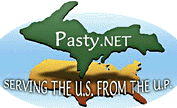By Waveaction (Lakelover) on Wednesday, June 26, 2013 - 04:36 pm:
Did you Yoopers know this;
When Michigan was a young territory, deer were so common and hunting was such a part of life that deer skins or whole deer were used as money. A deer carcass was worth one dollar and that's how the dollar became known for what's it worth - "a buck".
Just a bit of trivia for you folks.
More rain coming to Ontonagon, I can hear the garden growing. :)
By Capt. Paul (Eclogite) on Wednesday, June 26, 2013 - 07:47 pm:
Actually, the term "buck" goes way back, long before Michigan was ever dreamed of becoming a territory or state.
From the Etymology Dictionary:
Quote:Amer. Eng., perhaps an abbreviation of buckskin, a unit of trade among Indians and Europeans in frontier days, attested in this sense from 1748.
This is long before Michigan ever became a territory (June 30, 1805) or a state (January 26, 1837). It's even said that the term originated in the Ohio River Valley in 1748 after a frontiersman was robbed of 300 bucks, as cited in Mitford M. Mathews's A Dictionary of Americanisms.
And from the Stumblerz.com website:
Quote:So why do we call a dollar a buck?
It is said that the Indians taught the European settlers the value of a buck, because just like goat, gold or other livestock buckskin was used as a unit of trading, and from buckskin came the word buck, but that is not the reason why a dollar is called a buck. It became popular from the expression “the buck stops here” which was a well-known used line in the game of frontier poker, in which the back was a knife made of buckhorn and that was passed around the table to indicate the person who was dealing, each time a hand was finished the dealer passed the buck to the next player and this is where the word BUCK became popular and was used as dollar.
I'd like to know what references you used to post your information waveaction, especially the bit about using whole deer carcasses?

